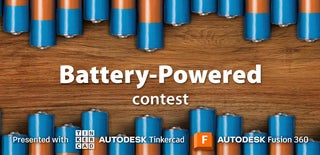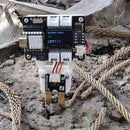Introduction: Battery Box Version 1
Greetings.
So here's a battery-related project called "Battery Box," and as the name implies, it's a box that contains a battery inside, as well as some cleverly made circuitry that was completely prepared from scratch.
The heart of this project is the DC-DC Buck Module, which was provided by PCBWAY from their giftshop. The muscle of this project is a custom 12V Battery Pack PCB, which includes an onboard lithium cell placed in three SMD 18650 Cell holders as well as a BMS setup for properly charging and discharging the battery.
The DC-DC Buck Converter module converts the 12V from the battery side to 5V 3A or QC3.0, which can be used to power XYZ devices. This is the main reason for building this project, so we can use a 12V battery pack to power things or charge smartphones.
The entire body was 3D printed from the ground up with yellow and transparent PLA.
Let's get started with this article about the battery box's construction process.
Supplies
Material Required
These were the materials used in this built-
- DC DC Buck converter circuit (Provided by PCBWAY)
- Custom PCB from a previous project
- 3S Li-ion Cell BMS
- Li-ion Cells 18650 3.7V 2900mAh
- Li-ion cell Holder 18650
- DC Jack
- 10K Resistor 0603 Package
- 5mm LED
- Screws
- Threaded insert
- 3D Printed parts
Step 1: DC-DC Buck Converter Module
I purchased this superb circuit from PCBWAY Giftshop.
This is a four-way fast charge module (12V/24V) that also supports QC3.0, Qualcomm's proprietary battery charging protocol used for managing power delivered over USB, primarily by communicating with the power supply and negotiating a voltage.
This Module is powered by four MH-KC-24 IC which is an Built-in synchronous switch step-down converter chip with an Input voltage range of 4.5V to 32V and can deliver 3V to 12V, automatically adjusted according to the fast charge protocol
It Support BC1.2, Apple, Samsung's agreement, Qualcomm QC2.0 and QC3.0, even MTK PE1.1 and PE2.0, and many more.
Step 2: PCBWAY Giftshop
As for sourcing this component, I got this circuit from PCBWAY's Giftshop
https://www.pcbway.com/project/gifts_detail/4_way_fast_charge_module_12V_24V_to_QC3_0.html
PCBWAY giftshop is an online marketplace where you can get a variety of electronics modules and boards for their genuine price or you could use the PCBWAY currency which is called beans.
You get beans after ordering something from PCBWAY as reward points or you can also get them by posting any project in the PCBWAY community.
Check PCBWAY out for getting great PCB service from here- https://www.pcbway.com/
Step 3: Battery Pack PCB Project Assembly
We begin this project by assembling the Battery Pack PCB, which was reused from an earlier project. This circuit is a simple battery management system breakout board that connects lithium cell holders to the BMS ports and has a DC jack for adding a 12V charger with this setup, and the BMS will control the charging and discharging.
Here's the original project-
https://www.instructables.com/LATTEintosh-Cooling-System/
- we add solderpaste to each component pad on the BMS side of the PCB.
- Next we place the BMS alopng with the diode and SMD resistor for the LED.
- we then pick and place this circuitry on the hotplate which heats this PCB from below upto the solder paste melting temp, solder paste melts and components get solder to their pads.
- Next we add three SMD Lithium Cell holder in their place along with DC jack with help of soldering iron on the bottom side of the PCB.
Board is now assembled.
Step 4: Power Source
- 3.7V 2900mAh In this project, cells are used as the primary power source; we place three cells in their holders in the correct orientation as indicated by the silkscreen.
- Next, we used a multimeter to measure the voltage across the BMS's output ins; it read 10.11V, indicating that the cells were nearly discharged and needed to be charged with a 13V charger.
Step 5: 3D Design
The 3D design is divided into two parts: the middle section and the base, with a lid on the middle section and a handle to transport the entire battery box from one location to another.
The lid is the topmost part of the design, and it covers the middle section with four M2 screws.
The middle section houses the main DC DC Buck converter circuit, which is the heart of this project. There are four USB Port slots in the middle section.
Two M3 bolts and threaded inserts connect the handle to the middle section.
The battery PCB is housed in the base, along with switches and terminal probes for 12V output.
The middle section is held together by four M3 screws on both sides (left and right)
Fusion 360 was used to model the entire battery box, which was then exported as a mesh file for 3D printing.
The middle part was printed with transparent PLA, while the base and handle were printed with yellow PLA using the same nozzle and layer height (0.6mm with 0.2mm layer height).
Step 6: Mid Section Assembly
- We begin the assembly by installing the DC DC converter and holding it in place with four M2 screws.
- Next, we insert threaded inserts into the mounting holes on both the left and right sides. We use a soldering iron heated to 100°C and press the insert downward; the heat causes the insert to warm up and deform the plastic, allowing it to slide right into the hole.
- We finish the Mid Section Assembly by adding inserts to both sides.
Step 7: Base Section Assembly
- Following that, we prepare the base part by gathering all of the materials we will need, which include the battery pack, banana clip connectors, rocker switch, and 5mm LED.
- We first place a rocker switch and a banana clip connector in their respective positions; the rocker switch will lock into place, and the banana clip connectors come with a nut for tightening them into their mounting holes.
- The Battery Pack is then connected to the rocker switch, banana pin connector, and LED.
- Base Section is now completed.
Step 8: Connecting Mid Part With Base Part
- Using connecting wires, we connect the P+ and P- of the battery pack to the Input +ve and -ve of the DC DC converter.
- A switch is connected between the positive line of P+ and the DC DC converter to turn on or off the power.
For proper connection, please see the attached wiring diagram.
Step 9: Final Assembly
- Finally, we connect the MID Section to the Base Section by inserting the midsection and securing it with four M2 screws.
- The lid is then placed in the middle and secured with four M2 screws.
- Finally, we install the Battery box handle using two M3 bolts that were previously secured by threaded inserts.
The project is now complete.
Step 10: Result
Here's the final result: a handy battery box capable of powering several 5V-powered devices, such as any arduino project that requires 12V output, or charging smartphones, tablets, or other devices.
The best part about this project is that we can carry it around with its handle and two banana pin terminals for getting 12V directly from the battery PCB fixed in the base body.
Because of the 2900mah cell inside that is being used to make a battery pack of 12.6V 2900mAh, the current power that we can use from this setup is around 36W/h.
Overall, this project was a success, and it will now be used in a future project that will use a solar panel with an additional setup to set up a simple solar nightlight.
Well, this is it for today, folks, If you have any trouble regarding this project, then leave a comment or DM me.
Special thanks to PCBWAY for supporting this project.
Check out PCBWAY for great PCB service at a relatively low cost.
Thanks again and peace out.

Participated in the
Battery-Powered Contest
















